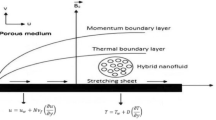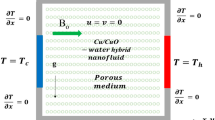Abstract
We investigate the discrete lattice effect of various forcing methods in the lattice Boltzmann method (LBM) to include the body force obtained from the immersed boundary method (IBM). In the immersed boundary lattice Boltzmann method (IB-LBM), the LBM needs a forcing method to involve the body force on a forcing point near the immersed boundary that is calculated by IBM. The proper forcing method in LBM is derived to include the body force, which appears to resolve problems such as multiphase flow, non-ideal gas behavior, etc. Many researchers have adopted different forcing methods in LBM to involve the body force from IBM, even when they solved similar problems. However, it is necessary to evaluate the discrete lattice effect, which originates from different forcing methods in LBM, to include the effect of the body force from IBM on the results. Consequently, in this study, a rigorous analysis of the discrete lattice effect for different forcing methods in IB-LBM is performed by solving various problems.
Similar content being viewed by others
References
Z. G. Feng and E. E. Michaelides, The immersed boundarylattice Boltzmann method for solving fluid-particles interaction problems, Journal of Computational Physics, 195 (2004) 602–628.
Z. G. Feng and E. E. Michaelides, A direct forcing method in the simulations of particulate flows, Journal of Computational Physics, 202 (2005) 20–51.
Y. Peng and L. S. Luo, A comparative study of immersedboundary and interpolated bounce-back methods in LBE, Progress in Computational Fluid Dynamics, 8 (2008) 156–167.
Dupuis, P. Chatelain and P. Koumoutsakos, An immersed boundary lattice Bolzmann method for the simulation of the flow past an impulsively started cylinder, Journal of Computational Physics, 227 (2008) 4486–4498.
G. Le and J. Zhang, Boundary slip from the immersed boundary lattice Bolzmann models, Physical Review E, 78 (2009) 026701.
X. Shi and N. Phan-Thien, Distributed Lagrange multiplier/ fictitious domain method in the framework of lattice Bolzmann method for fluid-structure interactions, Journal of Computational Physics, 206 (2005) 81–94.
X. D. Niu, C. Shu and Y. T. Chew, A thermal lattice Bolzmann model with diffuse scattering boundary condition for micro thermal flows, Computers & Fluids, 36 (2007) 273–281.
C. Shu, N. Liu and Y. T. Chew, A novel immersed boundary velocity correction-lattice Bolzmann method and its application to simulate flow past a circular cylinder, Journal of Computational Physics, 226 (2007) 1607–1622.
T. Gao and X. Y. Lu, Insect normal hovering flight in ground effect, Physics of Fluids, 20 (2008) 087101.
J. Wu and C. Shu, Implicit velocity correction-based immersed boundary-lattice Bolzmann method and its applications. Journal of Computational Physics, 228 (2009) 1963–1979.
X. Shan and H. Chen, Lattice Bolzmann model for simulating flows with multiple phases and components, Physical Review E, 47 (1993) 1815–1819.
X. He and L. S. Luo, Theory of the lattice Bolzmann method: from the Bolzmann equation to the lattice Bolzmann equation, Physical Review E, 56 (1997) 6811–6817.
N. S. Martys, X. Shan and H. Chen, Evaluation of the external force term in the discrete Bolzmann equation, Physical Review E, 58 (1998) 6855–6857.
J. M. Buick and C. A. Greated, Gravity in the lattice model, Physical Review E, 61 (2000) 5307–5320.
Z. L. Guo, C. G. Zheng and B. C. Shi, Discrete lattice effect on the forcing term in the lattice Bolzmann method, Physical Review E, 65 (2002) 046308.
X. Shi and S. P. Lim, A LBM-DLM/FD method for 3D fluid-structure interactions, Journal of Computational Physics, 226 (2007) 2028–2043.
O. E. Strack and B. K. Cook, Three-dimensional immersed boundary conditions for moving solids in the lattce-Bolzmann method, International Journal for Numerical Method in Fluids, 55 (2007) 103–125.
Y. Peng, C. Shu, Y. T. Chew, X. D. Niu and X. Y. Lu, Application of multi-block approach in the immersed boundary-lattice Bolzmann method for viscous fluid flows, Journal of Computational Physics, 218 (2006) 460–478.
D. J. Chen, K. H. Lin and C. A. Lin, Immersed boundary method based lattice Bolzmann method to simulate 2D and 3D complex geometry flows, International Journal of Modern Physics C, 18 (2007) 585–594.
Y. Sui, Y. T. Chew, P. Roy, Y. P. Cheng and H. T. Low, Dynamic motion of red blood cells in simple shear flow, Physics of Fluids, 20 (2008) 112106.
J. Hao and L. Zhu, A lattice Bolzmann based implicit immersed boundary method for fluid-structure interaction, Computers & Mathematics with Applications, 59 (2010) 185–93.
A. J. C. Ladd and R. Verberg, Lattice-Bolzmann simulations of particle-fluid suspensions, Journal of Statistical Physics, 104 (2001) 1191–1251.
U. Frisch, D. d’Humières, B. Hasslacher, P. Lallemand, Y. Pomeau and Rivet JP, Lattice gas hydrodynamics in two and three dimensions, Complex System 1 (1987) 649–707.
K. Höfler and S. Schwarzer, Navier-Stokes simulation with constraint forces: finite-difference method for particle-laden flows and complex geometries, Physical Review E, 61 (2000) 7146–7160.
Z. Yu and Z. Shao, A direct-forcing fictitious domain method for particulate flows, Journal of Computational Physics, 227 (2007) 292–314.
A. M. Roma, C. S. Peskin and M. J. Berger, An adaptive version of the immersed boundary method, Journal of Computational Physics, 153 (1999) 509–534.
X. Shan and G. Doolen, Multicomponent lattice-Bolzmann model with interpaticle interaction, Journal of Statistical Physics, 81 (1995) 379–393.
N. S. Martys and H. Chen, Simulation of multicomponent fluids in complex three dimensional geometries by the lattice Bolzmann method, Physical Review E, 53 (1996) 743–750.
X. He, S. Chen and G. D. Doolen, A novel thermal model for the lattice Bolzmann method in incompressible limit, Journal of Computational Physics, 146 (1998) 282–300.
L. S. Luo, Unified theory of lattice Bolzmann models for nonideal gases, Physical Review Letters, 81 (1998) 1618–1621.
Z. L. Guo, C. G. Zheng and B. C. Shi, Non-equilibrium extrapolation method for velocity and pressure boundary conditions in the lattice Bolzmann method, Chinese Physics, 11 (2002) 366–374.
M. Schäfer and S. Turek, Flow simulation with highperformance computer II, Note on Numerical fluid mechanics, 53 (1996) 547–566.
E. Ding and C. K. Aidun, The dynamics and scaling law for particles suspended in shear flow with inertia, Journal of Fluid Mechanics, 423 (2000) 317–344.
S. Hou, Q. Zou, S. Chen, G. D. Doolen and A. C. Cogley, Simulation of cavity flow by the lattice Bolzmann method, Journal of Computational Physics, 118 (1995) 329–347.
J. Feng, H. H. Hu and D. D. Joseph, Direct simulation of initial value problems for the motion of solid bodies in a Newtonian fluid, Journal of Fluid Mechanics, 216 (1994) 95–134.
Author information
Authors and Affiliations
Corresponding author
Additional information
Recommended by Associate Editor Gihun Son
ManYeong Ha received his B.S. degree from Pusan National University, Korea, in 1981, his M.S. degree, in 1983, from Korea Advanced Institute of Science and Technology, Korea, and his Ph.D degree from Pennsylvania State University, USA in 1990. Dr. Ha is currently a Professor at the School of Mechanical Engineering at Pusan National University in Busan, Korea. His research interests are focused on thermal management, computational fluid dynamics, and micro/nano fluidics.
Rights and permissions
About this article
Cite this article
Son, S.W., Yoon, H.S., Jeong, H.K. et al. Discrete lattice effect of various forcing methods of body force on immersed Boundary-Lattice Boltzmann method. J Mech Sci Technol 27, 429–441 (2013). https://doi.org/10.1007/s12206-012-1256-z
Received:
Revised:
Accepted:
Published:
Issue Date:
DOI: https://doi.org/10.1007/s12206-012-1256-z




